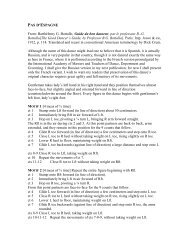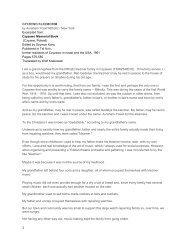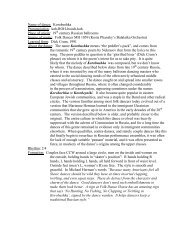Terkisher - Helen's Yiddish Dance Page
Terkisher - Helen's Yiddish Dance Page
Terkisher - Helen's Yiddish Dance Page
- No tags were found...
Create successful ePaper yourself
Turn your PDF publications into a flip-book with our unique Google optimized e-Paper software.
Name of dance: <strong>Terkisher</strong>Pronunciation: tehr-kish-ehrPlace of origin: Jewish communities of southern MoldaviaSource of music: Khevrisa: European Klezmer Music, SFW CD 40486, Band 18:“Bughici’s <strong>Terkisher</strong> Freylakhs”; also many recordings by NaftuleBrandwine and others, including modern interpretations such asThe Klezmatics: Between Two Worlds (Aviv Productions), Band 7:“Mizmor shir lehanef (Reefer Song)”.Learned from: Michael Alpert, 1999; with background information on Greek syrtosfrom Joe Kaloyanides GraziosiAbout the dance: The name of the dance means “Turkish”, and comes from a timewhen Turkish or Ottoman influence extended far beyond what is nowTurkey. During the 18 th and early 19 th century, when the area of Moldaviaand Bessarabia was in dispute between the Ottoman and Russian empires,an agreement was reached that the area would belong to Turkey but beruled by Greek Orthodox Christians, the so-called Greek Phanariots, toallow Russian control of the church there. Moldavia thus underwent anextended period of Greek influence, which included exposure to Greekmusic. Moldavian Jewish klezmorim would have been likewise exposed,and would probably have heard syrtos music, and seen the dances done toit. The Greek word syrtos means “pulled” and refers to the action of theleader of a dance line, who “pulls” the line along behind him.Judging from the style of this music that found its way into the MoldavianJewish klezmer repertoire, the type of syrtos in question comes from theGreek islands rather than from the mainland, and hence carries a rhythmicpattern of slow-slow-quick or 3-3-2 (as opposed to the mainland syrtos orkalamatianos, which is slow-quick-quick or 4-2-2). This gives it a liltingand somewhat languorous quality, well captured by the above Klezmaticssong about marijuana, a pastime probably more traditional than even theyimagine (though they do sing about its sanction by the Maggid ofMezerich!). Many terkisher tunes found in early klezmer recordings ofthe 20 th century such as those by Naftule Brandwine may not be oldMoldavian material at all, but are more likely taken directly from Turkishor Greek sources since they were played by klezmer musicians for Greekaudiences in Constantinople and New York. But the <strong>Terkisher</strong> Freylakhstune above does come from Avram Bughici of the Bughici family ofklezmer musicians from Iaşi, Moldavia. Whether Moldavian Jewsactually danced something like an island syrtos is a matter of speculation,since by the late 19 th and early 20 th century, the terkisher tunes in theklezmer repertoire were treated mainly as ones to listen to rather than todance to. But given that klezmer music already had plenty of listeningrepertoire (doinas, ballads, etc.), it seems unlikely that this infectiousmusic was originally imported only for its listening value. More likelythere were perhaps very simple dances that went with it that wereforgotten during the course of the 19 th century, the way dances often areforgotten for lack of a way to write them down or preserve them.
<strong>Terkisher</strong> (continued):If this is right, the dances are not hard to reconstruct, since the Greeksources are still with us, and can be reinterpreted through the filter ofklezmer and Moldavian dance styles. That is what is attempted here.Rhythm: 8/8, counted 1 – 2 – 3, 1 – 2 – 3, 1 – 2 ,or slow slow quickFormation: Line dance, hands held in “W” position, leader at the R end.Direction Measure StepBasic Step:→ 1 Facing and moving to the R, step on R (ct. S), step on L(ct. S), close R to L (ct. Q).2 Repeat Measure 1 with reverse footwork but in the samedirection.Note: This step can be done in a simple walking style, orwith more lilting movement by dipping into flexion on thefirst two counts and rising on the last, giving it a feel of“down-down-up”.Variation 1: Going backwardsRepeat Basic Step with same footwork, but face L as youmove to the R.Variation 2: TurningNote: This variation is for the leader to do as the rest ofthe line continues with the Basic Step.Let go of hand-hold and continue the Basic Step with aslow turn in either direction, resuming hand-hold whenthe turn (or turns) is complete.Variation 3: Swaying Travel→ 1 Facing and moving to the R, step R (ct. S), touch L forwardand somewhat toward center, possibly transferring weightjust briefly to it (ct. S), step on R in place (ct. Q).2 Repeat Measure 1 with reverse footwork but in the samedirection.
<strong>Terkisher</strong> (continued):Direction Measure StepVariation 4: In Place Facing Center↑ 1 Facing center, step on R toward center (ct. S), touch orbriefly transfer weight to L toward center (ct. S), step backon R in place (ct. Q).↓ 2 Step back on L (ct. S), briefly transfer weight to R awayfrom center (ct. S), step forward on L in place (ct. Q).Note: These variations are just embellishments on theBasic Step in a Greek island syrtos style. They can bemixed and matched and further embellished to suit themood of the dancers.dance notes by Erik Bendix







